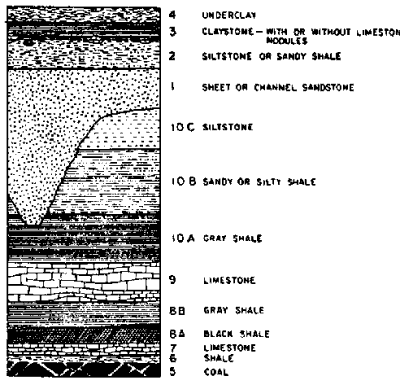 |
Science Frontiers ONLINE No. 55: Jan-Feb 1988 |
|
|
Cyclothems as solar-system pulse recorders
Geologists can help astronomers look back in time. The sunspot cycle can be seen in variations of varves; i.e., annual layers of sediment; and the growth rings of shells have been used to estimate the number of days in the lunar month when the solar system was younger. Cyclothems may also be useful. Cyclothems are groups or bundles of strata that repeat themselves in stratigraphic columns. A generalized cyclothem from Illinois is shown in the illustration.
In the U.S. western interior, rhythmic sedimentation appears in the Fort Hays Limestone Member of the Niobrara Formation. These cyclothems can be correlated over distances exceeding 800 kilometers and are believed to be the consequence of climatic changes associated with the earth's precession and orbital eccentriciy. These rhythms have been captured in bundles of shale-limestone couplets. A bundle of five coup lets, for example, is thought to express 21,000- and 100,000-year Milankovitchtype climatic cycles, as impressed by variations in the earth's orbital precession and eccentricity.
Analysis of the Fort Hays Limestone Member, however, reveals that while bundles of five couplets do occur, the number may vary from 1 to 12. Clearly, things are not clear-cut.
(Laferriere, Alan P., et al; "Effects of Climate, Tectonics, and Sea-Level Changes on Rhythmic Bedding Patterns in the Niobrara Formation (Upper Cretaceous), U.S. Western Interior," Geology, 15:233, 1987.)
Comment. As the rather comprehensive title of this article states, purely terrestrial forces may alter the rhythm. It may be, though, that cyclothem changes reflect actual changes in the earth's orbit resulting from astronomical catastrophism. The Cretaceous saw many geological and biological changes. Cyclothems may tell us more about them.
 | All ten members are never present at one location. The most common sequences are 1, and/or 2, 4, 5, 8, 9 and 10. |